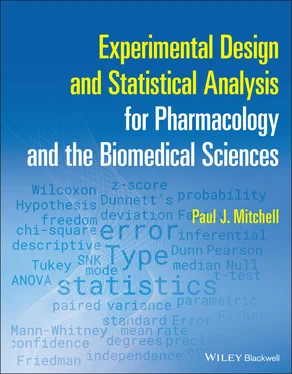1 ...7 8 9 11 12 13 ...16
The structure of this book: Descriptive and Inferential Statistics
The process of statistical analysis is broadly divided into two principle divisions. The first, and smaller, division is entitled Descriptive Statisticsand provides a range of values which allows the appropriate summary of experimental data. Such values include, for example, the Mean, Median, Mode, Variance, Standard Deviation, semi‐quartile range values,etc. and will be described in more detail in Chapters 5, 8 and 9. The second, and by far the larger division, concerns all the statistical tests that are employed to analyse data in order to draw appropriate conclusions about the relationship between different groups of values, and this division is entitled Inferential Statisticsand will be the focus of the remainder of this book (from Chapter 10onwards).
Before we continue this journey of discovery into the mystical world of experimental design and statistical analysis, I would just like to make a few comments about the approach and design taken throughout the book. To an experimental pharmacologist, statistical analysis simply provides a tool by which data obtained through robust experimentation may be understood. The purpose of this book is therefore to show the experimental pharmacologist how to use this tool: how to decide which statistical approach is appropriate for their data, how to prepare for and perform statistical analysis, and how to interpret the resulting output from the analysis. Consequently, this is very much a how‐to, hands‐onbook; what it is clearly not is an academic text focused on the vagaries of statistical theory – I really have little interest in why such tests work, I just need to know which test to use and when!
You will notice that the book is organised into (I hope, at least that is the plan) logical sections. Each section will contain a description of the test being described with some examples of experimental data and their statistical analysis. There are a range of software packages available to analyse scientific data, and I dare say, you, your lecturers, Department, or Institution will each have their favourite. Each of the analysis chapters, therefore, conclude with a number of Screenshotsshowing the appropriate output from a limited number of statistical packages (notably GraphPad Prism, InVivo Stat, MiniTab, and IBM SPSS) of the example data. My aim (or, at least, hope!) is that you will be able to perform you own analysis of the data examples and recognise the similarity between what you see herein and from your own efforts.
Throughout this Introduction, there is one word that pops up repeatedly, and that is the term data. So, what are data? Considering that the aim of this book is to show you how to subject data to appropriate statistical analysis, it is probably most important before we go any further that you understand exactly what data are and appreciate that there are different types of data.
So, sit back and tighten your safety belt as we start our journey into the realm of data.
Write Your Own Notes
As far as the experimental pharmacologist is concerned, data are simply numbers generated by our experimental observations. In some cases, the answer may be ‘Yes’ or ‘No’, ‘Present’ or ‘Absent’, where the observation has no discernible magnitude, but subsequently we assign value to these observations to allow statistical analysis. In other experiments, the data may simply be recorded as the number of times a particular event has occurred within a certain time period, for example, when a specific behaviour (e.g. head‐shake) is exhibited by rodents in behavioural experiments; such data are known as quantaldata. In other cases, data may be described as a continuous variable, such as height or blood pressure. So, data may have different characteristics, and it is important to ascertain the type of data obtained from our observations since this determines the subsequent approach for the Descriptive and Inferential Statistical analysis and the presentation of such data. For the time being, let us just consider how you are going to present your data.
Data handling and presentation
Whatever the type of data our experiment has generated, we need to present our results in some form or other such as text, tables, or figures. The form that is chosen depends on the type of data you have and the message you wish to convey.
Typically, data presented as textin the body of a manuscript (e.g. your laboratory report or that paper you wish to submit to the British Journal of Pharmacology). The following is a description of the phenylephrine data provided in the previous chapter (see Figure 1.3).
Figure 1.3summarizes the ability of increasing concentrations of the α 1‐adrenoceptor agonists, phenylephrine, to induce contractions of the isolated anococcygeus muscle of male Wistar rats in vitro ( N = 70). Data were analysed by Repeated Measures ANOVA. However, initial Mauchly's test indicated that the assumption of sphericity had been violated, χ 2(90) = 1903.64, p < 0.001; therefore the degrees of freedom in the subsequent Repeated Measures ANOVA test were corrected using Greenhouse–Geisser estimates of sphericity (ε = 0.156). The Repeated Measures ANOVA revealed significant variation between the contractile responses according to the final organ bath concentration of phenylephrine [ F (2.027, 139.862) = 1618.36, p < 0.001]. Post hoc analysis (repeated Paired t ‐test with Bonferroni correction) revealed significant differences between successive concentrations in all pairwise comparisons ( p < 0.01) except between the highest two concentrations examined ( p > 0.05). These data clearly show that the response of the anococcygeus muscle is dependent on the concentration of phenylephrine to which it is exposed. The threshold concentration to significantly induce a response was 2 × 10 −8M with a maximum response achieved at 4.1 × 10 −5M. The mean EC 50for phenylephrine was 3.6 (2.8, 4.7) × 10 −7M, p EC 50= 6.44.
Note that the manuscript description of the data contains the same factual information as the legend for the figure (see Figure 1.3) but allows the opportunity to provide some extra detail, and the language used does not have to be so concise.
Generally, tables are used by experimental pharmacologists for two principal purposes in reporting experimental data; either as a means of summarizing their own data from a series of experiments or to summarize a substantial collection of data or information from a series of previously published studies already in the public domain.
Table 2.1summarises the potency of atropine, a muscarinic cholinergic antagonist, and mepyramine, a histamine H 1receptor antagonist, to block the contractile responses to acetylcholine and histamine in the isolated guinea pig ileum in vitro .
Table 2.1 The relative potency of atropine and mepyramine on muscarinic and histaminic responses in the isolated guinea pig ileum.
|
Atropine |
Mepyramine |
| Acetylcholine |
9.0 |
>5.0 |
| Histamine |
5.8 |
9.3 |
Summary of p A 2values for atropine and mepyramine for acetylcholine‐ and histamine‐induced contractile responses in isolated guinea pig ileum in vitro . Data on file.
Читать дальше












